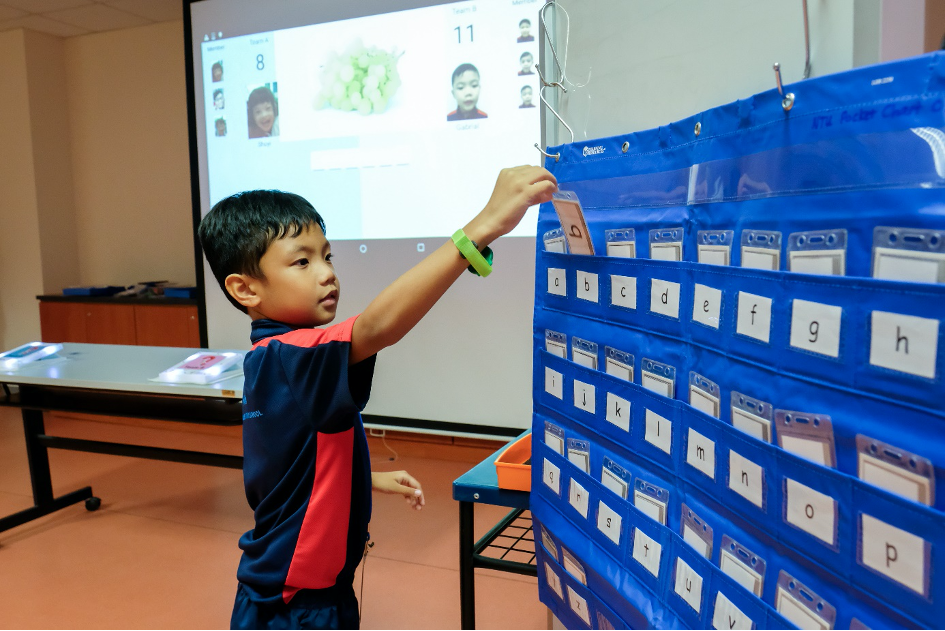Learning Through Collaboration, Play and Movement
30 Dec 2018
The i-Tile learning system, developed by Professor Goh Wooi Boon and his team, to support learning through purposeful collaborative play and movement. The systems were trialed at Rainbow Centre Yishun Park School and MINDS Fernvale Gardens School (Photo: Nanyang Technological University)
Professor Goh Wooi Boon observed that most children seem to be more attentive and energetic when they are moving around and playing with their friends, and wondered if appropriate technologies could be developed to allow teachers to conduct lessons in a similar manner, with the goal of improving the engagement levels and motivation of students.
This inspired Professor Goh and his team at the Nanyang Technological University (NTU) to develop the i-Tile technology, accompanied with interactive lessons and tools, to make learning more engaging for children. The team incorporated three main elements into their learning activities: collaboration, play and physical movement.
Since 2015, the research team has worked closely with the Movement for the Intellectually Disabled of Singapore (MINDS) Fernvale Gardens School, in designing lessons based on the i-Tile technology. The i-Tile technology and learning activities were trialed in 2018, involving 30 students from the school.
During the one-year trial, teachers saw an increase in enthusiasm and confidence among students. Students were motivated to learn their spelling words, including revising them at home. The i-Tile technology is a novel solution that helps children not only learn better, but bring about important life values such as patience, teamwork and taking turns. Two students from the trial made a marked improvement thanks to the i-Tile lessons, with one receiving a Good Progress Award and the other a Merit Award from the school.
The reconfigurable nature of the i-Tile system also allows teachers to adapt or create new activities at an affordable cost. For instance, teachers at MINDS Fernvale Gardens School are keen to use the i-Tile to help students remember their personal information, such as their telephone numbers and their home addresses. The i-Tile system can also teach students money skills and how to shop for items in a supermarket. With such a sustainable model, the i-Tile learning system has the potential to benefit more children, even those at the pre-school and lower primary levels.
Following the success of the field trial, MINDS Fernvale Gardens School plans to roll out the i-Tile learning system to the rest of their 180 students. Professor Goh’s research findings will also be shared with the other three MINDS school, so that they could consider adopting the system for their teachers and students.
How the i-Tile system work

Children have fun spelling words using the i-Tile (Photos: Nanyang Technological University)
The i-Tile system consists of two tablet computers and a custom-designed card-reader (the i-Tile) that can detect objects with Radio-Frequency Identification (RFID) such as a picture or alphabet card. The teacher facilitates the lesson using one tablet computer, whilst the other tablet computer acts as a coordinated remote display and is connected to the classroom’s projection display.
As an example, an image of an apple would appear on the screen and the student will have to move up to the front to select the corresponding word card and tap it against the i-Tile, which would then respond with the appropriate light and sound, indicating whether the choice is correct.
A variety of cards can be programmed by teachers allowing them to conduct an inclusive lesson with a class of students with differing levels of competencies. While one student can visually match using picture cards, another can spell using the correct sequence of alphabet cards.
In addition to the i-Tile, Professor Goh and his research team have developed the Spatial Awareness Mobile Device (SAMD) system. The SAMD system uses multiple smartphones to observe specially-designed colored patterns on a floor-based gaming arena. The learning activities require students to move in concert within this gaming arena, to make selections based on the task presented to them during each round of play. The SAMD learning activities help students improve their working memory, which in turn facilitate their learning of other skills such as reading, spelling and numeracy. The research team is currently conducting further trials of the SAMD system at MINDS Fernvale Gardens School.